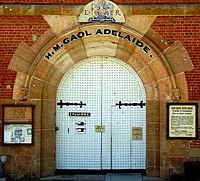Adelaide Gaol
 |
|
| Location | Adelaide, South Australia |
|---|---|
| Coordinates | 34°55′03″S 138°35′06″E / 34.9176°S 138.5849°ECoordinates: 34°55′03″S 138°35′06″E / 34.9176°S 138.5849°E |
| Status | Closed |
| Opened | 1841 |
| Closed | 1988 |
| Managed by | Department of Environment, Water and Natural Resources |
Adelaide Gaol was an Australian prison located in Thebarton, South Australia, Australia. The gaol was the first permanent one in South Australia and operated from 1841 until 1988. The Gaol is one of the two oldest buildings still standing in South Australia, the other being Government House which was built at the same time. The prison is now a museum, tourist attraction and function centre.
When the first colonists arrived at South Australia in late 1836, any prisoners (there were few at first) were held in irons aboard the ships HMS Buffalo and then Tam O'Shanter. In early 1837 the public were warned that escaped convicts from New South Wales may reach the colony and in mid-1837 Buffalo and Tam O'Shanter sailed away. Recognising the need, tenders had already been called for a "temporary" gaol. Meanwhile, the Governor's guard of Royal Marines held prisoners in their encampment in the present Botanic Gardens, chained to a tree.
As the population expanded, a temporary lock-up became necessary, which was built in early 1838 near Government House, Adelaide (then a mere hut) so the marines could guard both prisoners and Governor John Hindmarsh. This was a wooden slab affair, with timber palisade fences, although one room was freestone, which became known as the 'stone jug'. It was located at the north-east corner of present Government House Domain. In 1838, the first Sheriff, Samuel Smart, was wounded during a robbery that led to one of the offenders, Michael Magee, becoming the first person to be hanged in South Australia on 2 May 1838. When Governor Hindmarsh left, he also took all his marines, so the South Australia Police then ran the temporary gaol (through until Adelaide Gaol was built). Long term prisoners were sentenced to transportation in the eastern penal colonies, escorted there by police on inter-coastal ships. Even so, the gaol was overcrowded, sometimes holding up to seventy prisoners. Parts of the gaol became so "dilapidated that if it had not been for the building behind, [it] would have collapsed". In July 1838, it was reported that prisoners easily escaped because "the walls were rotten and there were gaps in the foundation".
...
Wikipedia
